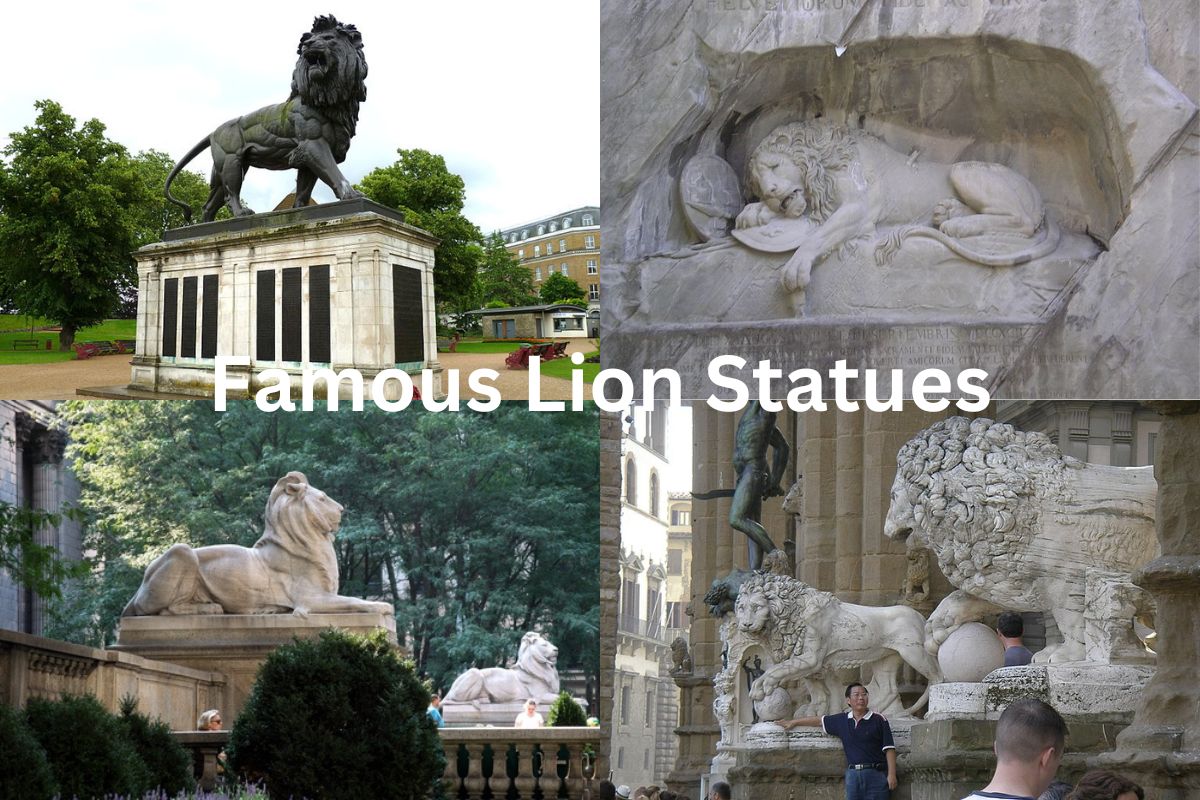Lion statues are a common and popular form of public art, found in cities and towns all over the world. These statues are often depicted in a variety of poses, including standing, sitting, and reclining, and are made from a variety of materials, such as stone, bronze, and marble.
Statues of lions have been used as symbols of power, strength, and courage for thousands of years, and they continue to be popular today.
Many lion statues have historical and cultural significance and are important landmarks in their respective cities or countries.
For example, the Lions of Trafalgar Square in London, England, and the Lions at the New York Public Library in New York City, USA, are iconic landmarks that attract millions of visitors each year.
Lion statues are also often associated with mythology and religion. In ancient Egyptian mythology, the lion was associated with the goddess Sekhmet, who was often depicted with the head of a lion.
In Hinduism, the lion is associated with the god Vishnu, and in Buddhism, the Buddha is often depicted sitting on a lion throne.
Overall, lion statues continue to captivate and inspire people all over the world, and they remain an enduring symbol of strength, power, and cultural heritage.
Famous Lion Statues
1. The Lion of Lucerne, Switzerland
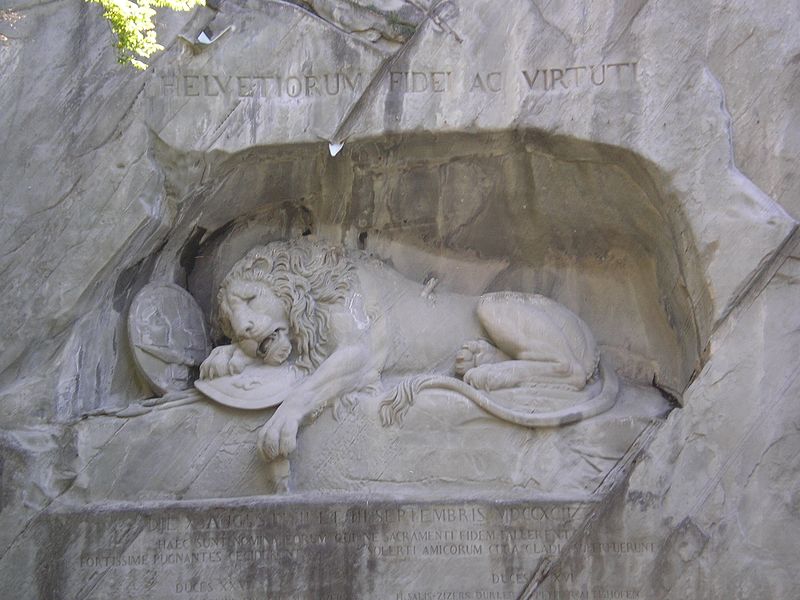
The Lion of Lucerne, Switzerland: The Lion of Lucerne is a famous lion sculpture carved out of a rock face in Lucerne, Switzerland.
It was designed by Danish sculptor Bertel Thorvaldsen and carved by Swiss sculptor Lukas Ahorn in 1820. The monument was created to commemorate the Swiss Guards who were killed during the French Revolution while defending King Louis XVI at the Tuileries Palace in Paris.
The sculpture depicts a mortally wounded lion lying on its side, with a spear jutting out from its side. Above the lion is a shield with the emblem of Switzerland, and the Latin inscription “Helvetiorum Fidei ac Virtuti” (To the loyalty and bravery of the Swiss).
2. Maiwand Lion, Reading
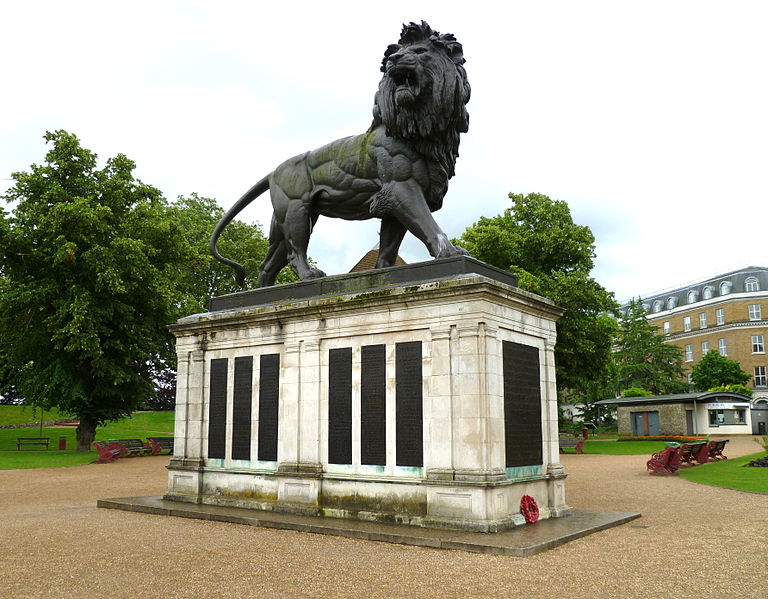
The Maiwand Lion is a famous monument located in Forbury Gardens, Reading, England. It was erected in 1886 to commemorate the deaths of 329 soldiers of the 66th (Berkshire) Regiment of Foot during the Battle of Maiwand in Afghanistan on 27 July 1880, during the Second Anglo-Afghan War.
The monument is a bronze statue of a lion standing on a tall plinth made of Portland stone. The lion is depicted with a wound on its shoulder and a defiant look on its face, as if it is ready to fight again.
Also Read: Famous Lion Paintings
The plinth bears the names of the soldiers who died in the battle, and the inscription reads, “To the memory of the officers, non-commissioned officers and men of the 66th (Berkshire) Regiment of Foot who fell in action at Maiwand in Afghanistan on the 27th July 1880”.
The Maiwand Lion was designed by George Blackall Simonds, a sculptor from Reading, and was cast at the H. Young and Co. foundry in Pimlico, London.
It is considered to be one of the finest examples of Victorian military sculpture and is a Grade II listed monument in England. The Maiwand Lion is a significant part of Reading’s history and is a popular tourist attraction in the city.
3. The Lion of Venice, Italy
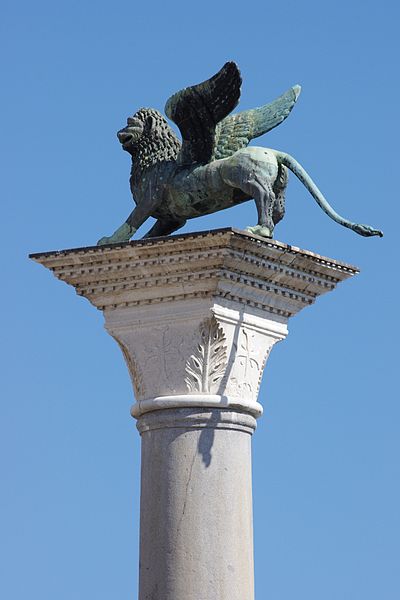
The Lion of Venice is one of the most famous lion statues in the world, located in Piazza San Marco (St. Mark’s Square) in Venice, Italy.
The statue is a bronze winged lion, which has been the symbol of Venice for centuries. It stands atop a tall granite column, known as the Column of Saint Mark, which was erected in the 13th century.
The Lion of Venice represents Saint Mark, the patron saint of Venice, who is traditionally depicted as a winged lion. The statue dates back to the 12th century and is believed to have been cast in Constantinople (now Istanbul) by Greek sculptors.
It was brought to Venice as spoils of war after the Fourth Crusade in the 13th century.
The lion’s wings symbolize the spirit of St. Mark, and its open book represents the gospel. The statue also features a halo around its head, which represents the saint’s divine status.
The column on which the lion stands was originally a gift from the Byzantine Emperor in 1172 and was later replaced by a new column in the 15th century.
The Lion of Venice is one of the most popular tourist attractions in the city and is a symbol of Venetian power and influence.
4. The Lion of Babylon, Iraq
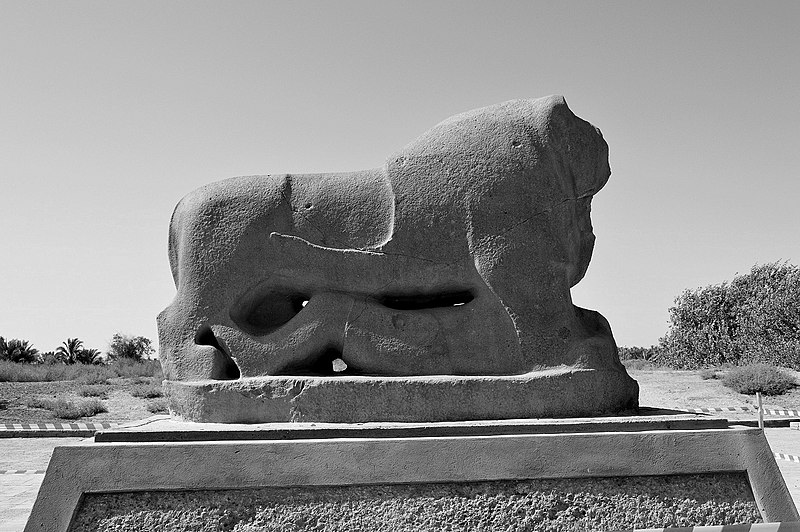
The Lion of Babylon is a famous lion statue that is located at the ancient city of Babylon, near the present-day city of Hillah in Iraq. The statue is made of black basalt and is believed to date back to the 6th century BC, during the Neo-Babylonian Empire period.
The Lion of Babylon statue is thought to have once been a part of the magnificent entrance to the city’s Ishtar Gate, which was one of the eight gates of the ancient city of Babylon. The statue was one of a pair of lions, which stood guard at the entrance to the gate.
The statue is a symbol of strength and power, and it represents the goddess Ishtar, who was associated with love, fertility, and war in ancient Babylonian mythology.
The Lion of Babylon statue is considered to be one of the most significant archaeological discoveries from ancient Mesopotamia.
Today, it is an important cultural and historical monument and is a popular tourist attraction in Iraq. It is also featured on the Iraqi coat of arms and is a symbol of the country’s rich cultural heritage.
5. The Trafalgar Square Lions
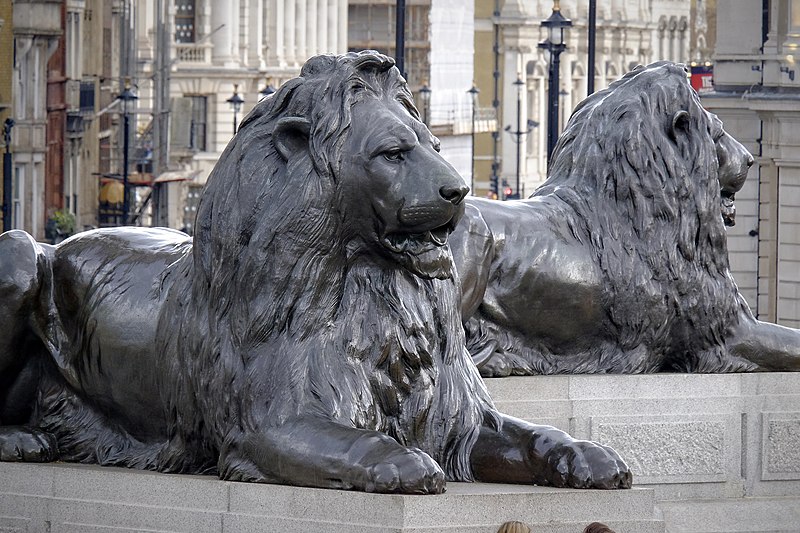
The Trafalgar Square Lions are a group of four iconic bronze lion statues that stand at the base of Nelson’s Column in Trafalgar Square, London, England. The statues were designed by Sir Edwin Landseer and installed in 1867.
Each lion statue weighs about 13 tons and stands at around 20 feet tall. They are depicted in a seated position, with their front paws resting on a ball, and are positioned facing in different directions.
The lion statues are considered to be some of the most recognizable and popular landmarks in London, attracting millions of visitors each year. They are also a popular spot for tourists to take photographs and are often used as symbols of London in films, television shows, and other media.
The lion statues were created as part of the redesign of Trafalgar Square in the mid-19th century, which was intended to commemorate the victory of Admiral Horatio Nelson at the Battle of Trafalgar in 1805.
The lions were added to the square to provide an imposing and majestic backdrop to Nelson’s Column, which stands at the center of the square.
The Trafalgar Square Lions have become a symbol of British culture and heritage, and they are often used to represent the strength, power, and majesty of the British Empire.
They are a testament to the skills of the sculptor Sir Edwin Landseer, who is considered to be one of the greatest animal sculptors of his time.
6. The Percy Lion
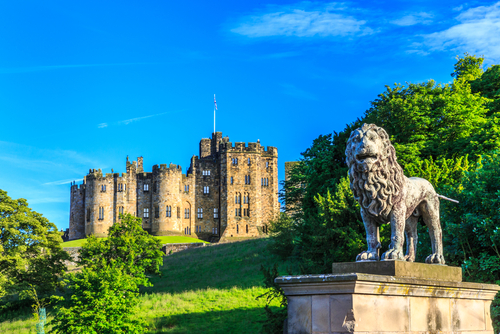
The Percy Lion is a famous lion statue located at Alnwick Castle, in Northumberland, England. The statue is made of stone and stands on a tall pedestal on the top of a hill overlooking the castle.
The statue depicts a roaring lion, with its mouth open and its teeth bared, standing on its hind legs. The lion is shown with a shield bearing the arms of the Percy family, which owns the castle.
The statue was created in the 18th century by John Van Nost, a Flemish sculptor, and was originally located in the grounds of Syon House, the London home of the Percy family. In 1780, it was moved to Alnwick Castle and placed on a pedestal, where it has remained ever since.
The Percy Lion is an important symbol of the Percy family’s history and heritage, and it is also a popular tourist attraction in Northumberland. It is one of several lion statues located at Alnwick Castle, including the Lion Bridge, which is another iconic landmark of the castle.
7. The Lions at the New York Public Library
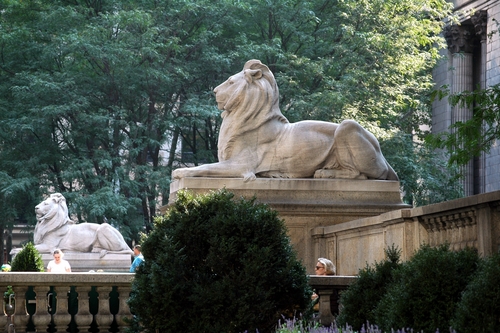
The Lions at the New York Public Library are two iconic marble lion statues that flank the entrance to the library on Fifth Avenue in New York City. The lions are officially named Patience and Fortitude and are among the most recognizable symbols of the city.
The statues were sculpted by Edward Clark Potter and were installed in front of the library in 1911. Each lion weighs approximately 13 tons and stands at around 11 feet tall. They are depicted in a seated position, with their front paws resting on a pedestal and their heads facing outwards.
The lions were named by New York City mayor Fiorello LaGuardia during the Great Depression in the 1930s. He chose the names to represent the qualities he believed were necessary for New Yorkers to get through the hard times – patience and fortitude.
The Lions at the New York Public Library have become an important cultural and historical monument in New York City. They are a popular tourist attraction and are featured in many films, television shows, and other media.
The library also uses the lions as part of its branding and marketing, with merchandise featuring their likeness being sold in the library’s gift shop.
The lions have become a symbol of the library and of the city itself, representing the intellectual and cultural heritage of New York. They stand as a testament to the importance of literature and learning, and they continue to inspire and captivate visitors from all over the world.
8. Medici Lions
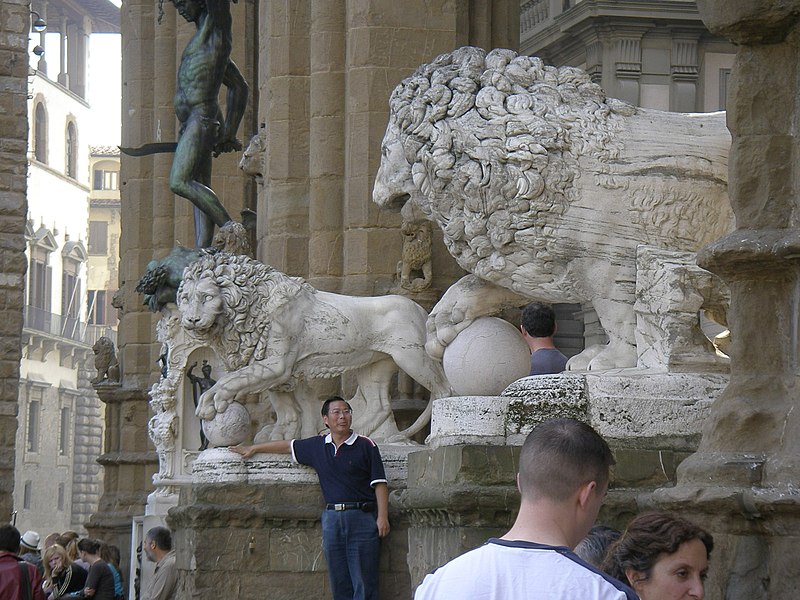
The Medici lions are a pair of lion sculptures made of marble; one is Roman and dates to the second century A.D., while the other is a 16th-century pendant. Both were in the Villa Medici in Rome by 1598.
Since 1789, they have been displayed in Florence’s Loggia dei Lanzi. The sculptures represent masculine lions standing with a spherical or ball under one paw and a sideways gaze.
Versions of the Medici lions have been reproduced and publicly shown in over 30 other locations, and smaller copies have been reproduced in a variety of media; the title Medici lion has become synonymous with the category.
A comparable sculpture of a Roman lion from the 1st century AD, known as the Albani lion, is currently on display in the Louvre. Here, the ball’s material is distinct from the basalt body. Both may have originated from a Hellenistic source.
9. The South Bank Lion
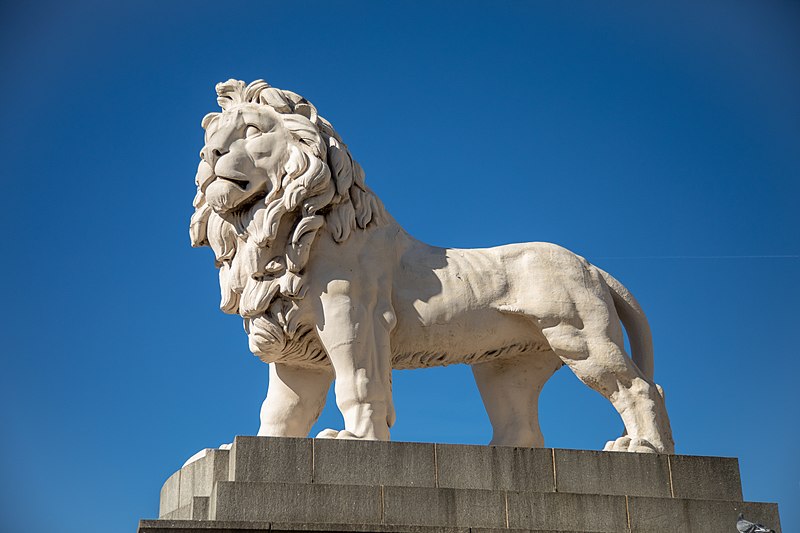
The South Bank Lion is a famous Coade stone sculpture of a reclining lion that is located in South Bank, London, England. The statue was created in 1837 by William F. Woodington and was originally located on the Lion Brewery building in the area.
The South Bank Lion is around 13 feet long and 12 feet tall, and it weighs about 13 tons. It is shown in a reclining position with its mouth open and its tongue hanging out, giving it a fierce and intimidating appearance.
The Lion Brewery building was demolished in the 1940s, but the lion statue was saved and was relocated to its current location in 1966. The statue was restored in the 1990s and is now a Grade II listed monument.
The South Bank Lion is an important cultural and historical monument in London, and it is a popular tourist attraction in the city. It is also used as a symbol of the South Bank area and is often featured in promotional materials for the area.
The lion’s impressive size and realistic detailing make it a remarkable piece of sculpture, and it continues to capture the imagination of visitors to South Bank.
10. Chinese Guardian Lion in the Forbidden City
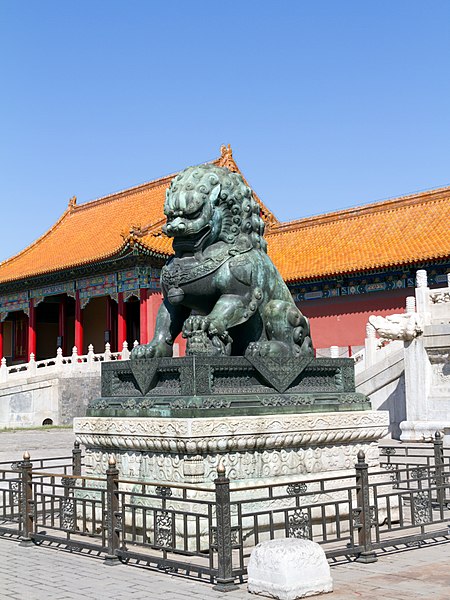
Chinese guardian lions, or imperial guardian lions, are a common architectural decoration in China, but their origins lay in much older Indian Buddhist traditions. They are often composed of stone and are sometimes known as stone lions.
The concept, which originated and became popular in Chinese Buddhism, features a pair of highly stylized lions — typically one male with a ball representing the material elements and one female with a cub representing the element of spirit — which were believed to protect the building from harmful spiritual influences and potentially dangerous individuals.
Statues of guardian lions have long stood in front of Chinese Imperial palaces, Imperial tombs, government buildings, temples, and the homes of government leaders and the wealthy, and were believed to provide legendary protection.

